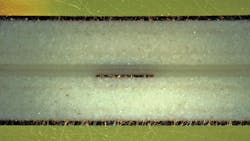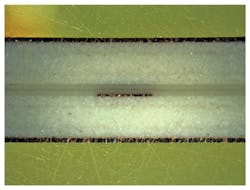This file type includes high resolution graphics and schematics when applicable.
Simply put, crosstalk will generally wreak havoc on high-frequency circuits and systems. These include simple devices such as radio integrated circuits (ICs), in which transmitted signals aren’t not properly shielded from or directed away from the receiver circuitry. Or it can deleteriously affect more complex, multiple-channel communications systems, in which signals from one channel may leak over to another channel.
RF/microwave crosstalk is essentially the unwanted conducting of high-frequency signals from one part of a system to another. It disrupts system operation, and must be avoided as much as possible through effective measurement and appropriate design practices.
High-frequency transceivers are susceptible to crosstalk because of an architecture that typically employs a high-output-level local oscillator (LO) with a frequency mixer and RF and intermediate-frequency (IF) amplifiers to perform frequency conversion The LO is often based on a tunable oscillator, such as a voltage-controlled oscillator (VCO) or a YIG oscillator, and can radiate or leak signal energy that becomes conducted by nearby transmission lines in a circuit or system.
To complicate matters, depending on the circuit layout, transmission lines in parallel that are very closely spaced (to form compact circuitry) can perform like antennas for signal energy conducted from, say, a high-energy source (e.g., an LO and “receive” energy from the source or from nearby transmission lines). As a result, it will conduct signal energy into components such as amplifiers, in which the crosstalk-signal amplitude levels are increased.
Crosstalk Enablers
RF/microwave circuits are susceptible to crosstalk due to numerous factors, including type of transmission line—microstrip, stripline, and grounded coplanar-waveguide (GCPW) transmission lines. Equations have been developed to calculate the amount of expected crosstalk from closely spaced parallel transmission lines, depending on factors like the distance between the transmission lines, the width of the transmission lines, and the permittivity (relative dielectric constant) of the printed-circuit-board (PCB) material. Crosstalk, which is essentially noise, can occur in either direction in a circuit. When close to the source of the noise (e.g., LO leakage) it’s often referred to near-end crosstalk, and when detected further from the source, it’s called far-end crosstalk.
Microstrip
With top-side conductors and bottom-side ground plane with dielectric material between the two, microstrip behaves most like an antenna when closely spaced transmission lines run in parallel (Fig. 1). The microstrip transmission line shown is fabricated on 20-mil-thick RO4003C PCB material from Rogers Corp. It’s a hydrocarbon ceramic laminate material with typical value of dielectric constant of 3.38 at 10 GHz, held to a tolerance of ±0.05.
Ideally, impedances in microstrip circuits can be closely matched to avoid mismatches and junctions susceptible to ringing and resonances that can boost crosstalk. Tight control of dielectric constant in a PCB material makes this possible. In addition, proper ground-plane management and generous spacing between parallel transmission lines can help minimize conditions for crosstalk. For example, any reduction in ground-plane inductance will increase isolation and reduce crosstalk. Even the choice of coaxial connectors can impact the crosstalk levels of a high-frequency analog or high-speed digital circuit.
Stripline
With transmission lines surrounded by dielectric material, stripline is less susceptible to crosstalk for two parallel transmission lines with the same spacing between them and the same width of transmission line. In stripline, high-frequency or high-speed signals are contained entirely within the PCB and the top and bottom conductive ground planes (Fig. 2). This minimizes emissions, and provides a good amount of shielding against incoming spurious signals.
A number of factors contribute to the amount of crosstalk produced in stripline circuits. These include the permittivity or relative dielectric constant of the circuit-board material, the height of the PCB’s dielectric material, the length of the section of closely spaced parallel transmission lines, the height of each transmission line, and the spacing between the two transmission lines.
GCPW Transmission Lines
Thanks to their top-mounted transmission-line conductor on a PCB, surrounded on either side by ground planes, GCPW transmission lines (Fig. 3) achieve high isolation from coupled noise and thus minimize crosstalk. The GCPW’s effective dielectric constant becomes equivalent to the combination of the permittivity of the dielectric PCB material on which the circuit traces are mounted, and the permittivity of air (unity) that surrounds the conductive traces and the ground planes. Microstrip and stripline circuits are somewhat more susceptible to crosstalk than GCPW circuits because of their generous grounding.
In general, any close placement of circuit traces that run parallel on a dielectric substrate will create a circuit structure that’s essentially a capacitor. This section of the circuit will be capable of capacitive coupling and crosstalk, depending on the permittivity of the dielectric material. A number of other factors, including substrate dielectric loss, conductor loss, line thickness, and transmission-line width will contribute to the amount of crosstalk that occurs for a particular PCB.
It’s a Matter of Space
For single-layer, high-frequency analog and high-speed digital circuits, the areas of greatest concern are where transmission lines run in parallel. On multilayer circuits, areas of concern are where transmission lines from different circuit layers cross one another. In both cases, the close spacing of the transmission lines separated by the PCB’s dielectric material forms a parasitic capacitor that’s subject to coupling effects and crosstalk.
Current is coupled from the transmission lines with the intended signals to the nearby transmission lines. It’s then transmitted through the parasitic capacitance between the two transmission lines. Depending on the impedances of the different transmission lines, the coupled current can result in voltage spikes that can degrade performance in analog circuits and disrupt operation in digital circuits.
In multilayer circuits, the use of grounded viaholes can also help to minimize crosstalk. For effective shielding, the grounded viaholes must be placed closer together as the circuit’s operating frequency climbs upward. In addition, differential circuit topologies are often used to achieve increased immunity to crosstalk.
Since high-speed digital signals exhibit the characteristics of high-frequency analog signals in terms of propagation and conduction, crosstalk is a concern for designers of high-frequency analog and high-speed digital circuits, and especially for designers of circuits containing both types of signals.
Although increasing the spacing between parallel transmission lines or the distance between lines that cross over each other in multilayer circuits can thwart attempts to miniaturize a PCB, it helps reduce or minimize crosstalk. Decreasing the length of a section of closely spaced parallel transmission lines can also help to shrink crosstalk for that portion of circuitry, since the amplitude of the crosstalk tends to rise with the increased length of the parallel transmission-line section.
In addition, using a low-impedance guard transmission line or circuit trace between two parallel transmission lines will work to reduce crosstalk. No doubt, separating analog and digital functions on a single-layer PCB is one of the simplest methods for minimizing crosstalk, although it also may mean a less-than-efficient use of PCB area.
Power-supply circuitry is also susceptible to crosstalk from signal sources like LOs and clock oscillators. Under worst-case conditions, power-supply circuitry can conduct fundamental and harmonic signals from an oscillator throughout a circuit, with leakage signals added to the inputs of any amplifiers in the circuit to increase amplitude. Utilizing a decoupling capacitor in a circuit’s power-supply filtering can help cut down the occurrence of crosstalk through the power-supply lines.
Measuring Crosstalk
The effects of crosstalk can be obvious in a communications system, such as loss of service or degraded system performance. Crosstalk can be difficult if not impossible to measure within packaged components and ICs, and removing the package changes the effective operating environment for the circuitry.
Of course, at the design stage, key goals are to create circuit structures and configurations that are the most rugged against crosstalk, and choose PCB materials that best support the design’s target performance levels without contributing to crosstalk. Effective measurements and appropriate computer-aided-engineering (CAE) software tools are essential to designing and characterizing RF/microwave circuits for minimal crosstalk.
Equipment for evaluating crosstalk should be capable of wide frequency ranges and wide dynamic range, given the relatively low levels of crosstalk compared to desired signals in a circuit or system. Crosstalk measurements are typically made in the time domain with time-domain reflectometers (TDRs), and in the frequency domain with microwave vector network analyzers (VNAs).
TDRs are useful for evaluating crosstalk as it pertains to the performance and signal integrity of high-speed digital circuits. Microwave VNAs can provide impressive dynamic range (of typically 80 dB or more) and are able to quickly measure and analyze forward and reverse signal transmission and reflection data without changing measurement setups. High-performance microwave VNAs that can accurately measure crosstalk are available from a number of companies, including Anritsu Co., Keysight Technologies, and Rohde & Schwarz.
In the digital realm, crosstalk is often measured with the aid of bit-error-rate (BER) testers. That’s because excessive crosstalk has been found to compromise the BER performance of high-speed digital circuits. By generating test signals that closely emulate the actual signals to be carried by the circuits under test, such as with an arbitrary waveform generator, it’s possible to examine crosstalk’s impact on the signal integrity (SI) of a high-speed digital circuit’s signal integrity (SI). It compares the difference between circuit operation with and without input signals (and with and without crosstalk).
In addition to characterizing a circuit design through wide-dynamic-range measurements, computer-aided-engineering (CAE) software tools such as electromagnetic (EM) simulation software can save time when exploring potential crosstalk issues with a circuit design.
Software tools like the Sonnet Suites from Sonnet Software make it possible to predict the EM behavior of different circuit configurations and types of transmission lines, including the effects of PCB materials. In fact, Sonnet offers SonnetLite as a free download from its website, as a form of risk-free introduction to the use of a three-dimensional (3D) EM simulation tool. Additional suppliers of high-quality EM simulation tools include Computer Simulation Technology (CST), Keysight Technologies, National Instruments, and Remcom.
These measurement and simulation tools can help monitor and minimize crosstalk for a wide range of circuit architectures and substrate materials. Essentially, what’s important to know isn’t so much the level of crosstalk, but the effects it has on a circuit’s performance and essential functions. Through careful circuit design and spacing of any parallel transmission lines, crosstalk can usually be held in check, even at the highest frequencies and fastest digital speeds.
This file type includes high resolution graphics and schematics when applicable.
About the Author
Jack Browne
Technical Contributor
Jack Browne, Technical Contributor, has worked in technical publishing for over 30 years. He managed the content and production of three technical journals while at the American Institute of Physics, including Medical Physics and the Journal of Vacuum Science & Technology. He has been a Publisher and Editor for Penton Media, started the firm’s Wireless Symposium & Exhibition trade show in 1993, and currently serves as Technical Contributor for that company's Microwaves & RF magazine. Browne, who holds a BS in Mathematics from City College of New York and BA degrees in English and Philosophy from Fordham University, is a member of the IEEE.




